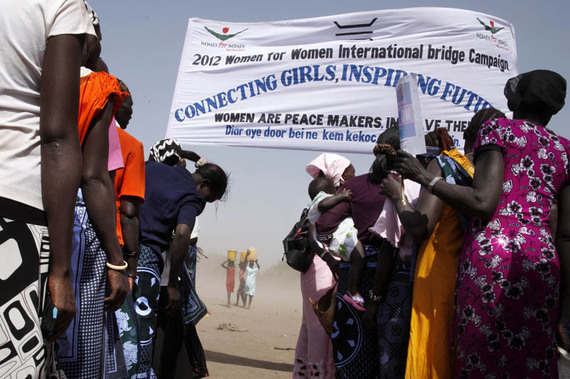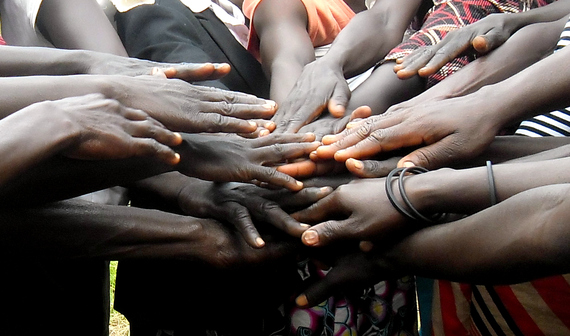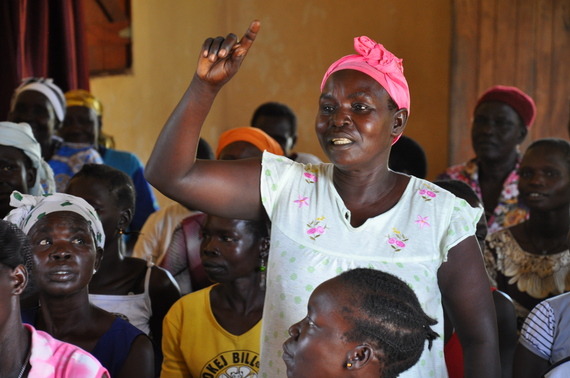"We thought it was going to be fighting, fighting until all of us died," recalls Mary, a widow and mother of five who lost her husband and other family members during the Second Sudanese Civil War that ended 11 years ago this week.
When Mary shared her story with Women for Women International (WfWI) in mid-2012, she told us how peace had given her new hope for the future in South Sudan.
"Now we realize we have a life, so my first hope is that I'm going to live longer," she said. "My second hope is that people will not fight again."
Mary's dreams of peace did not come true. A year and a half later, violence broke out in South Sudan again, and today the country continues to struggle with a conflict that has forced more than 2.3 million people to flee.
What If Women Were at the Peace Table?
There are numerous drivers of conflict in South Sudan, and the world's newest country has faced serious challenges since its independence from Sudan in 2011. However, there is one overlooked factor that perhaps could have prevented a resurgence of violence: a peace table that included women.
Recent research has found that enabling local women to participate in peace processes increases the probability of violence ending within a year by 24 percent, and that institutionalizing gender equality can help build peaceful societies.

In South Sudan, women come together to celebrate International Women's Day and advocate for women's roles as peace-makers. Photo credit: Brian Sokol, 2012
Yet no women were included as lead mediators or signatories to the Comprehensive Peace Agreement ending Sudan's civil war. Just nine percent of witnesses to the signing were women.
Promoting Women's Roles as Local Peace-builders
"The community is not living together as one people," says Anna, a 50-year-old widow and mother of six in Yamba, Mugwo Payam, Yei River County. While the violence that has surged in other parts of South Sudan has not yet touched her own community, she worries that it may and sees signs of smaller-scale violence happening.
Years of war had prevented her children from getting an education, and Anna was forced to leave school after 5th grade. As a women leader of her church in Yamba, Anna says, "I always talk about [the importance] of harmony and peace in the family and community."
Determined to do more, Anna joined 19 other women in a three-day training last year to learn how they could take action to build peace in their own communities supported by Women for Women International through funding by Cordaid.
Understanding the Causes of Conflict and Violence
Challenging the widespread exclusion of women from peace-building efforts around the world, Anna and 19 other WfWI graduates from Yamba, Wadupe, and Sanjasiri came together to develop a deeper understanding of the dynamics of conflict and skills in leadership and advocacy that would help them raise their voices in their communities. They discussed causes and different forms of conflict and violence in their communities, and learned how they could mediate and address interpersonal and intergroup conflicts to prevent them from becoming violent.
In South Sudan, a woman participates in WfWI's yearlong training program. Learn more. Photo credit: Women for Women International, 2013
For Anna, understanding how she can intervene has helped her serve as a mediator in her community. Recently, a woman came to Anna for help, after her husband threatened to divorce her for giving birth to a girl, rather than a boy. Anna met with the woman's husband, and counselled him on how his actions were harming his family, and mediated a discussion between the husband and wife. "There is now peace in the family," says Anna.
Raising Their Voices and Advocating Change
During the three-day training, the women also learned leadership, communication, and advocacy skills to help them advance women's roles in peace-building in their community and raise issues of concern to them.
Inspired by what they learned, the women drew up plans for peace-building activities in their communities and arranged meetings with their local chiefs to discuss how they could work together to promote peace and encourage their community-wide participation. For many of these women, it was their first time meeting and speaking with the chiefs, and an important moment for their voices to be heard.

After the peace-building training, WfWI participants join hands to promise they will continue to advocate for peace in their communities. Photo credit: Women for Women International, 2015
Taking Action for Peace
In Sanjasiri, Mary A. is leading up her community's first peace-building campaign. She's bringing together local leaders and others to implement the plan of action she and other women designed during their peace-building training. A 35-year-old mother of five, Mary organized an awareness-raising session with 20 community members, where they talked about women's rights issues - such as marriage decisions - through the lens of conflict resolution. Together, they participated in role-plays on how to reconcile cases of conflict in the family and community and to bring about a peaceful resolution.
Women leaders in Yamba held a similar awareness-raising session with women and men in their village, focusing on how violation of women's rights and other negative norms and actions can promote conflict within families and communities.
Through public conversations and campaigns that address local issues and focus on how to come together to resolve differences, women like Anna and Mary A. are playing a critical role as mediators and proponents of peace in their communities. Recognizing how violations of women's rights are sources of conflict and violence, they are raising their voices to advocate for greater respect for the rights of all community members, and building a foundation for more inclusive, peaceful communities.
To learn more, visit www.womenforwomen.org.
